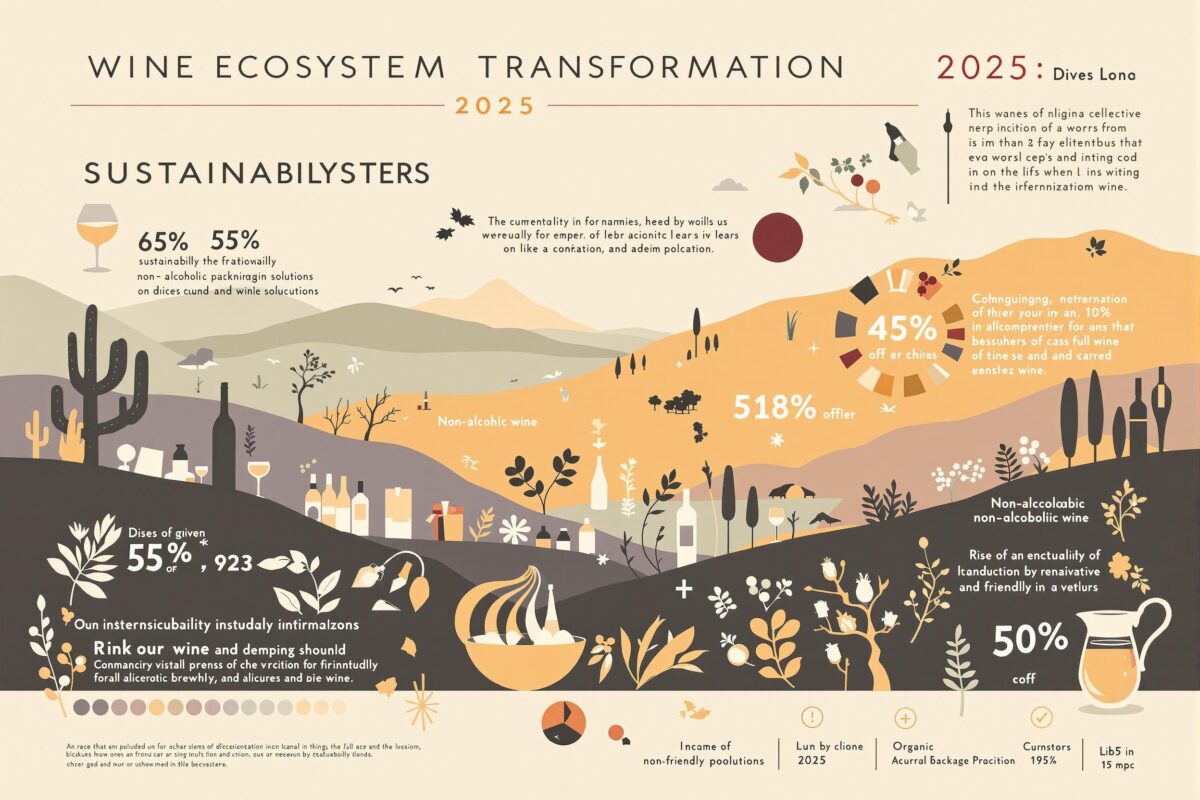Wine Trends 2025: Navigating the Sustainable and Health-Conscious Beverage Landscape
The beverage sector is transforming. Consumer preferences are evolving, and there’s a heightened awareness of health and environmental impact. Wine trends in 2025 reflect these shifts. Think non-alcoholic options, innovative mocktails, and sustainability as the new norm. This article explores these key trends, offering insights for navigating this dynamic landscape.
Exploring the Trends: Non-Alcoholic Wine, Mocktails, and Low-Alcohol Innovation
The Rise of Non-Alcoholic Wine: A Category Redefined
Non-alcoholic wine has moved from the sidelines to center stage. Expect robust growth in 2025, driven by health-conscious consumers and the desire for inclusive options. Sophisticated production methods now preserve flavor and complexity, as seen with brands like Oddbird and their organic, dealcoholized wines. Once stigmatized, non-alcoholic choices are now appreciated for their versatility and health benefits. Just look at the popularity of “Dry January.” This mainstream acceptance is fueled by ongoing research and development, resulting in refined products available at various price points and varietals. Smart marketing and consumer education are also key.
Mocktails and Low-Alcohol Beverages: A Refreshing Shift
Mocktails and low-alcohol beverages are trending, especially among younger demographics seeking moderation. They offer a spectrum of flavors and experiences, aligning with health-conscious demands. Mocktails, once basic juice blends, are now complex concoctions featuring premium ingredients. Low-alcohol wines and spritzers cater to those seeking reduced alcohol content without sacrificing taste. It’s about mindful consumption and experiential drinking, quality over quantity. The innovation here mirrors the craft cocktail scene, elevating non-alcoholic choices. Pairings with food are also gaining traction, further solidifying their place in 2025.
Sustainability in Focus: Packaging Solutions Reducing Carbon Footprint
The Imperative of Eco-Friendly Products
Sustainability isn’t optional; it’s a consumer-driven demand. Eco-friendly packaging is a key differentiator for brands. Consumers actively seek brands prioritizing sustainability, driving changes in packaging practices. The focus? Reducing carbon footprint and promoting circular economy principles. This is true across all beverage categories, including wine. Consumers are even willing to pay a premium for eco-friendly products, showcasing their commitment. Transparency in sourcing and production is also vital.
Innovative Packaging Solutions: Reusable and Recycled Materials
Reducing carbon footprint requires innovative solutions. Reusable bottles and recycled materials are leading the way. Reusable bottle programs, while complex, offer significant waste reduction. Recycled glass and aluminum are also gaining traction. Lightweighting materials without compromising product integrity is another strategy. Plant-based alternatives, still developing, hold promise for reducing plastic reliance. Collaboration across the supply chain, from brands to recycling facilities, is crucial. Consumer participation in recycling programs is also key.
Organic Wine Market: Growth & Key Players Driving Eco-Based Demands
Key Players: Pioneers of Eco-Conscious Viticulture
Key players in the organic wine sector are championing sustainable viticulture. They’re committed to organic farming, eschewing synthetic solutions for natural alternatives. Brands like Oddbird exemplify this influence. These wineries produce high-quality organic wines and promote sustainable practices. Consumer awareness of organic wine is rising, fueled by the desire for healthier, eco-friendly products. Organic certification provides transparency and traceability. These key players are often smaller estates prioritizing quality and sustainability. Collaboration and consumer education initiatives are strengthening the sector. Their commitment is inspiring others to adopt more sustainable practices.
Driving Forces: Health, Environment, and Taste
The organic wine market is booming due to health and environmental concerns and a growing appreciation for taste. Consumers seek to avoid synthetic chemicals, and environmental concerns drive demand. But there’s more. Organic wines offer distinct flavor profiles and a sense of place. They’re perceived as higher quality, offering a more authentic experience. The market’s tripling reflects these driving forces. Retailers are expanding organic wine selections, and restaurants feature them on their menus. Media coverage further raises consumer awareness. Government support also plays a role.
Innovations Visualized: Infographic of the 2025 Wine Ecosystem Transformation
Imagine an infographic showcasing the ‘Wine Ecosystem Transformation 2025’. It would highlight sustainability, connecting organic viticulture, sustainable packaging, and carbon footprint reduction. The growth of non-alcoholic wine, innovative packaging solutions, and the expanding organic wine market would be visualized with key statistics. A timeline could show the evolution of wine trends. Key players like Oddbird would be featured. This infographic would communicate the interconnectedness of these trends, transforming the wine ecosystem. Easy-to-understand visuals would make it accessible and engaging.
Actionable Insights
For businesses, adapting requires a strategic approach. Consider expanding non-alcoholic offerings, highlighting sustainable practices, and educating customers about trends. Explore organic and biodynamic wines, monitor consumer preferences, and partner with sustainable suppliers. Invest in informative content about wine trends, sustainability, and the benefits of organic wines.
Planning for the future requires a long-term vision centered on sustainability and health. Carbon neutrality goals, the shift toward low-alcohol beverages, and the rise of mocktails are changing consumer habits. Embracing circular economy principles and investing in research for sustainable viticulture are essential. Consumer education, industry collaboration, and supportive government policies are crucial. A proactive approach focused on innovation, collaboration, and consumer engagement is key.
